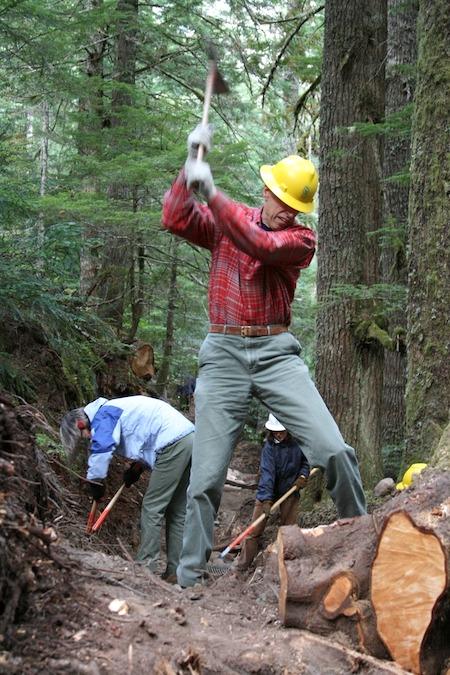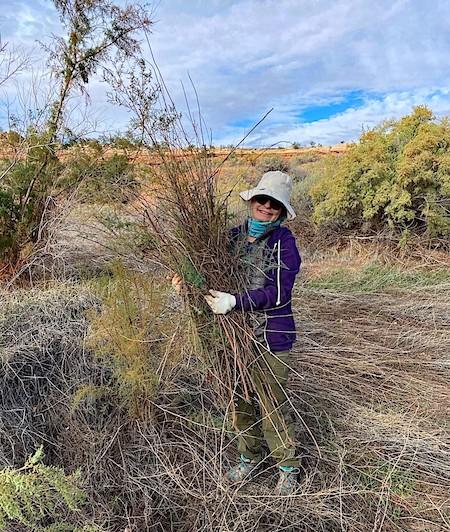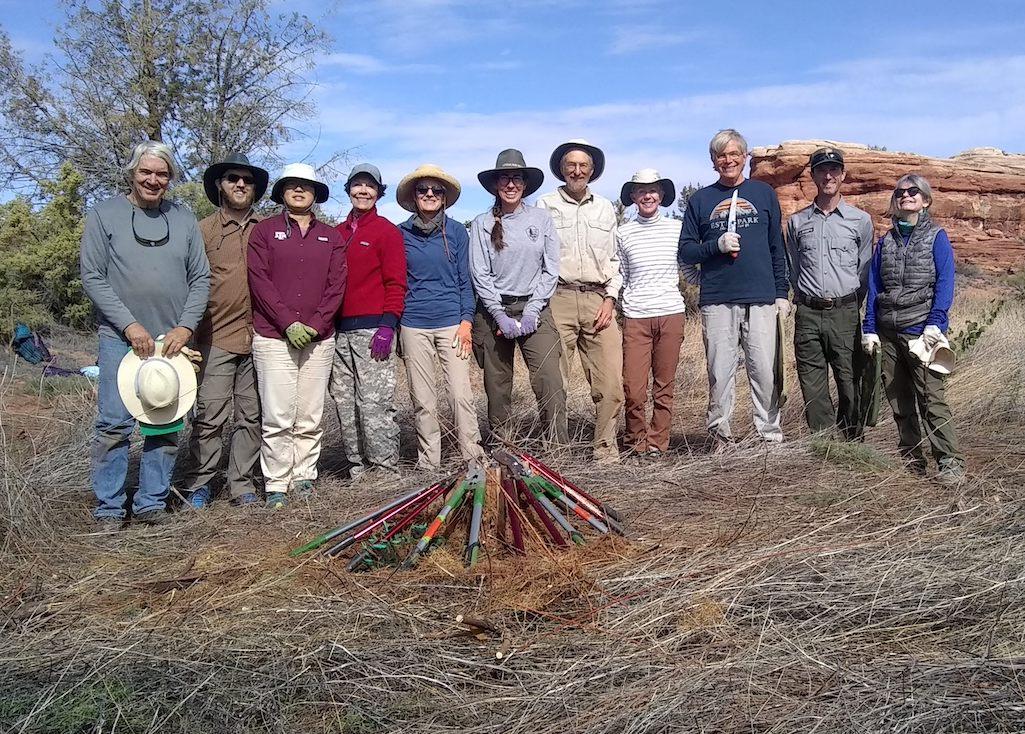
Volunteers from Washington's National Park Fund work on a section of the Wonderland Trail/NPS file
If you’ve spent much time exploring our national parks, you’ve undoubtedly run into some of the nearly 300,000 Americans who in a typical year offer their services as VIPs, or “Volunteers in Parks.” They may have sold you a book in a park visitor center or answered your questions about hiking trails. You might have run into a volunteer patrolling one of those trails or leading an interpretive walk.
VIP programs encompass every aspect of park operations, from Revolutionary War re-enactments at North Carolina’s Moores Creek National Battlefield to clearing brush from around a visitor center in Utah’s Canyonlands National Park.
The latter group would have been us, nine volunteers who took part in a week of service last October in Utah’s largest and least-developed national park. We’d assembled in Canyonlands’ Needles District from three time zones, with a core group coming from Austin, Texas. The project was organized by Stan Peyton, a friendly and gregarious attorney from that city, who has been organizing such projects for years under the auspices of his local Sierra Club. He had, in fact, just returned from a week of volunteer service in Montana’s Glacier National Park.
Joining Stan was his partner Leslie, as well as six others who drove long distances to witness the colorful cliffs and hoodoo domes here in the heart of the Colorado Plateau. As the sole Utahn, I attempted an interpretation of the local geology, but got lost somewhere between explaining salt anticlines and the formation of grabens. Clearly, I was not ready to don a seasonal volunteer’s uniform and give a campfire talk. No matter, for there was plenty of work to be done with our hands during the week we spent in the Needles.
We spent our first day creating a narrow firebreak around the visitor center and employee housing, then retired to one of the Needles District’s three group campgrounds for a family-style dinner and conversation. The setting sun promised a photo op, so Stan, who had camped here before, led us up a set of wooden ladders placed on the slickrock walls to reach a fine view of the iconic Sixshooter Peaks, glowing orange in the clear air. The modest use of our muscles that day was a warmup for the harder work ahead.
Each morning after breakfast, Sofia Nicholson, our Park Service liaison, showed up in her government truck to explain the day’s program. We set off for the nearby Salt Creek drainage, where we met Kelly and Josh, vegetation management specialists from the agency’s Southeast Group office in Moab. Under their direction we cleared invasive tamarisk seedlings from along the creek, part of an ongoing effort to reduce fire danger and promote native vegetation in this drainage.

Collecting Russian thistle in Arches National Park/NPS, Sofia Nicholson
The work was steady but not terribly taxing, which suited me fine. Pausing to rest, I asked Josh about the many wildflowers and other native plants that were emerging after some welcome late-summer rains. This led to a discussion of the ecology of this drainage, which had been heavily grazed by livestock until 1975 and was still in the stages of recovery.
Assisting with ecological management is only one of the myriad ways volunteers can serve our national parks. A look through the pages of www.volunteer.gov, the federal volunteer service webpage, reveals an array of opportunities as varied as the Park Service mission itself.
How about sorting seeds in a native plant nursery at Point Reyes National Seashore? Assisting with geographic information systems at Denali National Park and Preserve in Alaska? Or cleaning headstones at Chalmette National Cemetery in Louisiana? One position that has long intrigued me is that of astronomy volunteer at one of the many dark-sky locations in our national park system. I’ve lugged my telescope to astronomy festivals at both Bryce Canyon and Great Basin national parks, helping hundreds of visitors to appreciate the cosmos, but a growing number of parks are bringing on knowledgeable amateur astronomers to conduct public programs all summer long.
Volunteer opportunities in the National Park System range from events such as National Public Lands Day, when many parks host volunteers from local communities to take part in activities such as trail maintenance or litter cleanup, to seasonal positions that fill an identified need such as campground hosts, visitor center staff, and backcountry patrols.

Removing tamarisk at Canyonlands National Park/Stan Peyton
There are also service projects such as ours in Canyonlands, which are typically carried out by members of a nonprofit group, community organization, or even a single person with a particular job in mind. Nicholson told us of one volunteer from Moab who has been collecting roadside litter in Arches and Canyonlands national parks for years. Besides beautifying the roadways, her efforts help to reduce the danger to wildlife from ingesting human food and other garbage.
In recent years, questions have been raised about using volunteers to carry out work that regular Park Service employees perform, such as staffing visitor centers or conducting ranger walks. One concern is whether the agency has come to rely so heavily on such volunteers that Congress sees less need to fund regular staff positions (see “Volunteers Are Integral To The National Park System, But Can There Be Too Many?,” NPT May 17, 2017). Volunteers may not have the same level of training as an experienced park ranger, although I’ve been served by some extremely knowledgeable VIPs here in Utah.
Under the Volunteers in the Parks Act of 1969, which formalized the NPS’s volunteer programs, the use of non-professionals to carry out important tasks in the National Park System has grown substantially. Park Service policy is that volunteers will not replace paid staff, but with the agency’s budgets in a perennial state of starvation, one has to wonder whether the great tradition of volunteerism among Americans is enough to keep our parks running efficiently in an era of exploding visitation.
Regardless, all kinds of folks are stepping forward for what amounts to an insider’s experience in a national park, national monument, or national historic site—working across the desk, as it were, from the average tourist. The experience of serving alongside NPS staff gives a fuller picture of a park operations, highlighting the challenges they face daily.
Some seasonal volunteer positions provide housing, while others (such as campground hosts) may be given a spot to park their RV for the summer. Other positions are limited to those who live in the local area and can commute to the park site. We were happy to have the use of a group campground for our week in Canyonlands, free of charge. This requires making arrangements with park staff well in advance, however.
Our work removing tamarisk seedlings from Salt Creek clearly augmented, rather than replaced, the efforts of Canyonlands’ own work crews. We also spent several afternoons collecting native seeds from a recovering grassland along the entrance road to the Needles District, where decades of revegetation work was paying off in a field of lush bunchgrasses and forbs such as globemallow. As I wandered through this rich ecosystem, snipping off the seedheads of a specified percentage of the grasses we were collecting, I realized I was getting an education in the biotic function of this corner of Canyonlands.
That had also been the case for a project my wife and I took part in earlier last year at Nevada’s Great Basin National Park. Rangers there put on an annual “BioBlitz,” a five-day event in which volunteers join park naturalists in surveying particular plants or animals and entering observations on an online database such as iNaturalist. Last year’s focus was on snakes and lizards, and included lectures by herpetologists as well as field time with knowledgeable rangers and other volunteers. This, too, provided us with a rich educational experience.
I asked Sofia Nicholson whether projects such as ours in Canyonlands are worth the time it takes for park staff to make arrangements and supervise us. She was emphatic in affirming that they do, and allowed (with a smile) that such projects also got her out of the office and into the field. In a follow-up email, she described a similar project carried out by volunteers in Arches National Park, who over a week’s time collected several hundred pounds of invasive Russian thistle, forming a pile six feet high and 20 feet long. It was hard work, she said, pulling plants that scratch one’s arms and cling stubbornly to the ground.

The volunteers who tackled tamarisk at Canyonlands National Park/Fred Swanson
Educating the public about park resources and values is a key element of the Park Service’s mission, Nicholson noted, and projects such as ours are an excellent way to gain a deeper understanding of a place like Canyonlands. By the end of the week we, too, could look back on some genuine accomplishments. Clearing out the tamarisk from a short stretch of Salt Creek had opened up space for a variety of native vegetation.
Kelly and Josh gained a substantial collection of carefully bagged and labeled seeds to spread on disturbed areas in the park. Employees in the Needles District housing thanked us for clearing around their residences, and one staffer who happened to be at home at the time brought us a plate of delicious homemade muffins.
I left Canyonlands with more appreciation for the long hours and sometimes difficult conditions under which park employees work. The unseen barrier that often exists between staff and visitors had been lowered a little, and that felt good. On my last night in camp, after most of our group had left for home, Stan, Leslie, and I mulled where we might go for next year’s project. It’s not too soon to begin planning yours!
# # #
Frederick Swanson is the author of Wonders of Sand and Stone: A History of Utah’s National Parks and Monuments (University of Utah Press, 2020). His website is www.fredswansonbooks.com.



Add comment